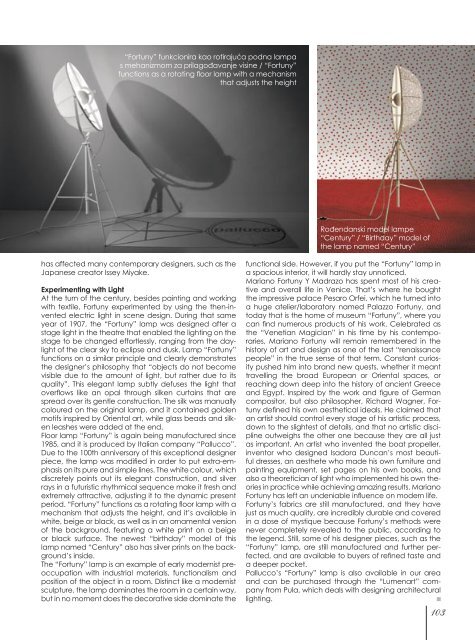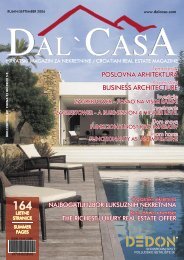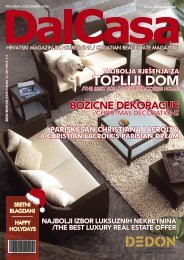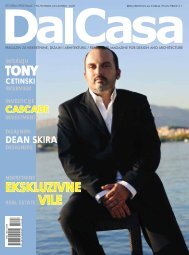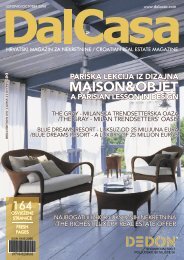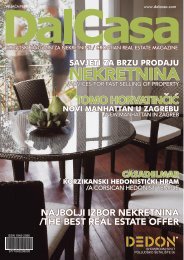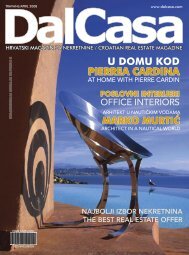100% DESIGN LONDON - DalCasa
100% DESIGN LONDON - DalCasa
100% DESIGN LONDON - DalCasa
Create successful ePaper yourself
Turn your PDF publications into a flip-book with our unique Google optimized e-Paper software.
“Fortuny” funkcionira kao rotirajuća podna lampa<br />
s mehanizmom za prilagođavanje visine / “Fortuny”<br />
functions as a rotating floor lamp with a mechanism<br />
that adjusts the height<br />
Rođendanski model lampe<br />
“Century” / “Birthday” model of<br />
the lamp named “Century”<br />
has affected many contemporary designers, such as the<br />
Japanese creator Issey Miyake.<br />
Experimenting with Light<br />
At the turn of the century, besides painting and working<br />
with textile, Fortuny experimented by using the then-invented<br />
electric light in scene design. During that same<br />
year of 1907, the “Fortuny” lamp was designed after a<br />
stage light in the theatre that enabled the lighting on the<br />
stage to be changed effortlessly, ranging from the daylight<br />
of the clear sky to eclipse and dusk. Lamp “Fortuny”<br />
functions on a similar principle and clearly demonstrates<br />
the designer’s philosophy that “objects do not become<br />
visible due to the amount of light, but rather due to its<br />
quality”. This elegant lamp subtly defuses the light that<br />
overflows like an opal through silken curtains that are<br />
spread over its gentle construction. The silk was manually<br />
coloured on the original lamp, and it contained golden<br />
motifs inspired by Oriental art, while glass beads and silken<br />
leashes were added at the end.<br />
Floor lamp “Fortuny” is again being manufactured since<br />
1985, and it is produced by Italian company “Pallucco”.<br />
Due to the 100th anniversary of this exceptional designer<br />
piece, the lamp was modified in order to put extra-emphasis<br />
on its pure and simple lines. The white colour, which<br />
discretely points out its elegant construction, and silver<br />
rays in a futuristic rhythmical sequence make it fresh and<br />
extremely attractive, adjusting it to the dynamic present<br />
period. “Fortuny” functions as a rotating floor lamp with a<br />
mechanism that adjusts the height, and it’s available in<br />
white, beige or black, as well as in an ornamental version<br />
of the background, featuring a white print on a beige<br />
or black surface. The newest “birthday” model of this<br />
lamp named “Century” also has silver prints on the background’s<br />
inside.<br />
The “Fortuny” lamp is an example of early modernist preoccupation<br />
with industrial materials, functionalism and<br />
position of the object in a room. Distinct like a modernist<br />
sculpture, the lamp dominates the room in a certain way,<br />
but in no moment does the decorative side dominate the<br />
functional side. However, if you put the “Fortuny” lamp in<br />
a spacious interior, it will hardly stay unnoticed.<br />
Mariano Fortuny Y Madrazo has spent most of his creative<br />
and overall life in Venice. That’s where he bought<br />
the impressive palace Pesaro Orfei, which he turned into<br />
a huge atelier/laboratory named Palazzo Fortuny, and<br />
today that is the home of museum “Fortuny”, where you<br />
can find numerous products of his work. Celebrated as<br />
the “Venetian Magician” in his time by his contemporaries,<br />
Mariano Fortuny will remain remembered in the<br />
history of art and design as one of the last “renaissance<br />
people” in the true sense of that term. Constant curiosity<br />
pushed him into brand new quests, whether it meant<br />
travelling the broad European or Oriental spaces, or<br />
reaching down deep into the history of ancient Greece<br />
and Egypt. Inspired by the work and figure of German<br />
compositor, but also philosopher, Richard Wagner, Fortuny<br />
defined his own aesthetical ideals. He claimed that<br />
an artist should control every stage of his artistic process,<br />
down to the slightest of details, and that no artistic discipline<br />
outweighs the other one because they are all just<br />
as important. An artist who invented the boat propeller,<br />
inventor who designed Isadora Duncan’s most beautiful<br />
dresses, an aesthete who made his own furniture and<br />
painting equipment, set pages on his own books, and<br />
also a theoretician of light who implemented his own theories<br />
in practice while achieving amazing results, Mariano<br />
Fortuny has left an undeniable influence on modern life.<br />
Fortuny’s fabrics are still manufactured, and they have<br />
just as much quality, are incredibly durable and covered<br />
in a dose of mystique because Fortuny’s methods were<br />
never completely revealed to the public, according to<br />
the legend. Still, some of his designer pieces, such as the<br />
“Fortuny” lamp, are still manufactured and further perfected,<br />
and are available to buyers of refined taste and<br />
a deeper pocket.<br />
Pallucco’s “Fortuny” lamp is also available in our area<br />
and can be purchased through the “Lumenart” company<br />
from Pula, which deals with designing architectural<br />
lighting.<br />
103


